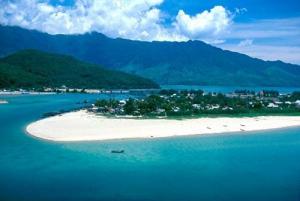Danang: More Than A Beach

The Central Coast of Vietnam, particularly ${bigcity_Da_Nang:"Da Nang"}, is in the process of development unlike any other in the history of Vietnam. It is said to be “the next best thing since Bali and Phuket,” but in a different way.
Unlike the beaches in Phuket though, the coastal waters of Danang are not as placid as Andaman Sea. In fact, Danang is often hit by tsunamis. December, January and February are especially terrible months for tourism in the area. But what Danang lacks in beaches, it more than makes up for its culture and recreation. Golf, biking (bicycle and mountain bike), photography, trekking, rock climbing and motorbiking are just some of the activities guests can enjoy at the place.
Danang’s beaches are at par with Bali’s, but there’s a saying, “People don’t go to Bali for the beach anyway.” They go to the place more to experience the culture, that is, see the landscape, temples and art. When it comes to this, Central Vietnam, Danang, is in the same level.
- ${bigcity_Hoi_An:"Hoi An"} is a UNESCO-recognized World Heritage Site, along with My Son, ${bigcity_Hue:"Hue"}, and Phong Nha. Indonesia is said to be Danang’s rival when it comes to cultural attraction, and the former isn’t even as accessible as the latter, especially now that the new international airline terminal has just been opened.
Unlike ${bigcity_Hanoi:"Hanoi"} and ${bigcity_Ho_Chi_Minh_City:”Saigon”}, Danang (along with Hue and ${bigcity_Hoi_An:"Hoi An"}), have “immediate access” to the natural environment. The landscape is something that no city or even beach can come at par with. The Phu Xuan bridge in Hue is like a painting with its majestic mountains and overall natural beauty. The My Son valley is one of a kind, with breathtaking mountains you’ll never see somewhere else.
Unlike other cultures, too, in Central Vietnam, what matters more is the relationship between the people and their “intimate” space. Lacking commercial and big establishments, the experience you get from walking down the streets and meeting the local people is something you will hold in your memory forever.
But Danang is not exactly living in the past anymore. Today, multi-million dollar amenities are mushrooming in the place in the form of resorts, hotels and other tourism facilities. The Nam Hai, Hyatt Regency Danang, Life Heritage Resort Hoi An and La Residence Hotel and Spa are just some of the luxurious destinations guests can come to and enjoy.
In fact, a giant Indonesian destination marketing organization led by John Blanco is currently under talks with the region’s golf courses, restaurateurs, airlines and tourism authorities with the goal of “A publicity campaign the likes of which we’ve not seen anywhere in Southeast Asia.” Blanco has a vision of launching a massive media outreach and creating an active website to promote the place.
According to him, for the past 20 years, Vietnam has been a favorite place for travelers. But this time, it’s ready for the nest step, for the vacationers, people who stay in a particular place for at least a week and not just pass through. And that’s where Danang steps up. Because aside from the beach, people stay longer for the sights and the Vietnamese people themselves. The palaces, mountains, local towns, and the hospitality of the Danang residents are something guests become easily home to.
Danang may fall back behind in several points, but unlike the others, it has a history, a story to tell that sets it apart and above from everyone else.









